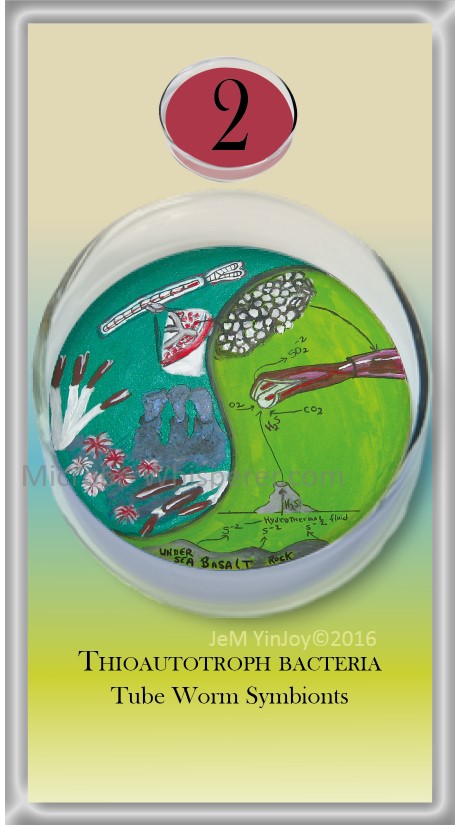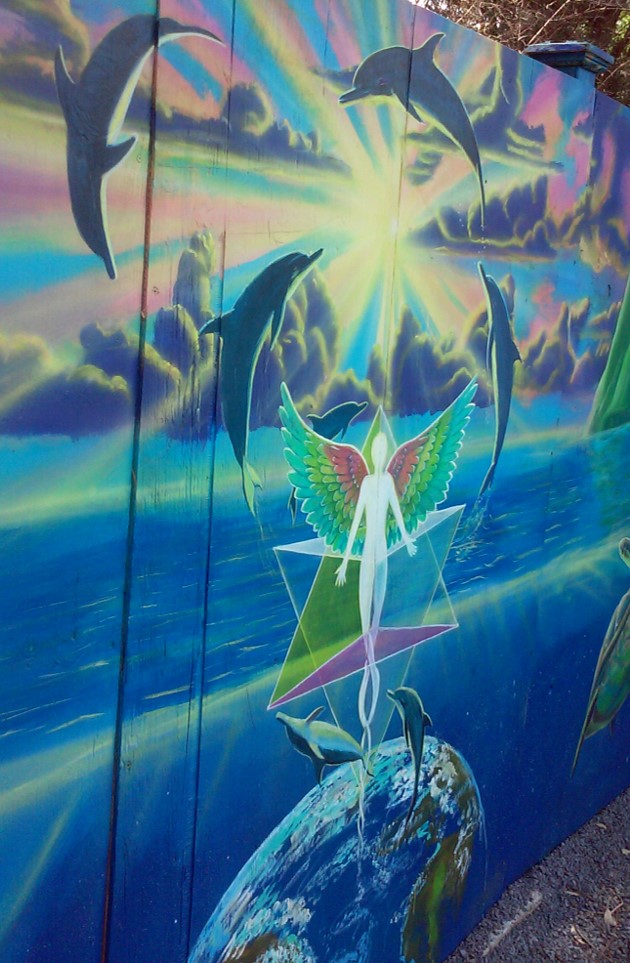
|
Haiku for Thioautotrophs Few greater bonds can be, Than between this worm and microbe In the sea. By JeM YinJoy |
Scientific description - (for a VISIT TO HEAVEN AND HELL, and the Video, skip this section and scroll down)
Thioautotrophs (thigh-Oh-Auto-trofs) are intracellular sulfur-oxidizing bacteria that are the primary producers of carbon for the adult tubeworm, called Riftia, which completely depends on these symbionts for its nutrition.
These bacteria oxidize reduced inorganic sulfur compounds to make ATP, the cellular fuel life forms need to live.
These tube-worm symbionts are Gram negative bacteria that pack themselves within the trophosome, a highly vascularized organ in the trunk of the tubeworm Riftia pachyptila.
Riftia pachyptila is a giant tube-dwelling annelid that lives in deep-sea chemosynthetic communities, which include hydrothermal vents. The adult tubeworms are devoid of a functioning digestive system, such as gut, mouth and anus, which makes them completely dependent on microbial endosymbionts for food.
The host tubeworm gives the microbes the means for uptake and transport of the HS-, O2,and CO2, the molecules that the microbes use to feed by thioautotrophy.
What the microbes gives to the tube worms in return is “side dishes” or organic matter that these symbiotic microbes make while they eat.
What it does for the environment -
As for the contribution that the tubeworm microbial symbionts make to the environment, these microbes have the potential to contribute to our future habitats which will not depend on sunlight and plants.
An ecosystem relies on organisms that can fix carbon dioxide to organic carbon. On the surface of our earth, these organisms are plants, or other photosynthetic organisms such as algae and photosynthetic microbes (blue-green algae).
But under the sea, the task of being the primary producer, which is usually the job of the plants and other photosynthetic organisms on the sunlight capturing part of earth’s surface, is taken over by the microbes such as the sulfur-oxidizers of the tube worm symbionts.
As humankind develops alternate living environments, whether to explore other planets, or previously uninhabitable places like the deep ocean, learning how to replicate primary producer roles by using photosynthetic alternatives such as the sulfur oxidizing bacteria, will be vital to survival.
The knowledge gained by microbiologists now will contribute to the artificially created environments in such scenarios mentioned above, where it can be envisioned that the microbes which now produce nutrients chemosynthetically to feed tubeworms, could be engineered to feed similar types of life, that could then provide nutrition for the human residents in these alternative habitats.
Our role as humans will continue to evolve in step with the environmental challenges that we face, as climate changes continue to have an impact on where we can live on the planet.
Alternative primary producers will play a key part in how we prepare to live in environments that might be devoid of the solar energy, where photosynthesizers like plants will no longer be able to act as our primary producers.
Spiritual significance
Endosymbionts evolved alongside their hosts for millennia. So much evolution together was bound to create an inseparable bond.
The host, in this case the tube worm Riftia- has bent over backwards and sideways to modify its own worm body to accommodate its endosymbionts.
Not out of the goodness of its troposomal heart, but really, because the tube worms cannot live without its microbial symbionts.
No one is sure how the meeting between the ancient free-living symbiont and tube worm first met, but it might have gone something like this.
Pre-endosymbiont – “I have to work so hard to scrape together a few HS-, O2 and CO2 molecules just to eek out a living in this undersea vent neighborhood
Pre-tube worm host – “Why don’t you take a load off in my tube chamber? I could use a few extra ergs of ATP from you.”
And the ultimate codependent relationship was born!
Seriously though, the relationship between the endosymbiont and Riftia tubeworms suggests a deeply spiritual lesson, one that is illustrated best by a Chinese parable rooted in Buddhism that recounts a man’s visit to heaven and to hell.
A Visit to Heaven and Hell:
A man asks his Angel to show him Heaven and Hell.
The angel leads him first a large dining hall, where he sees row after row of tables laden with platters of sumptuous food; yet the people seated around the tables are pale, starved and miserable.
Coming closer, he sees that each person is holding a long spoon, but that both his arms are splinted with wooden slats so that he cannot bend either elbow to bring the food to his mouth.
“This is Hell” the Angel informs him.
The Angel then takes him to an identical place.
Entering the dining hall there, he sees the same scene, except in contrast to Hell, the people seated at the tables who had their arms splintered with wooden slates were sitting contentedly, cheerfully talking with each other, as they enjoyed their sumptuous meal.
The man was amazed that each person at a table was feeding the person sitting across from him.
“This is Heaven.” The angel informs him.
How perfectly the Rifita symbiont and its host illustrate this lesson. Without each other, they would suffer in a hell of starvation. Together, they have created heaven, under the sea.
Aspiring Microbe Whisperers, do watch this Video about Endosymbionts and Tube Worms to appreciate the beauty of this heaven under the sea!
JeM YinJoy















Comments 1
Nice blog. Made sence.